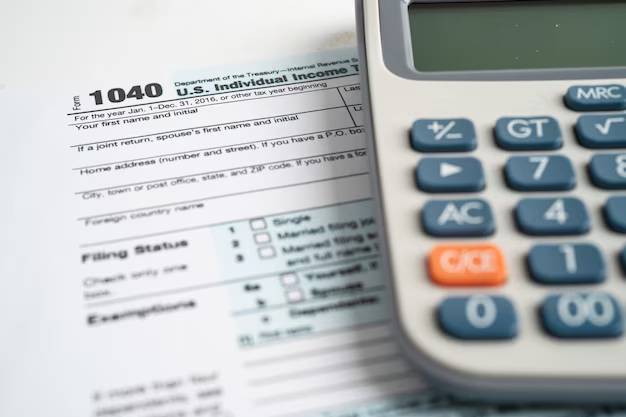Understanding the 1040 Form: Your Guide to Tax Season Success
Tax season is an annual event that prompts a flurry of questions, concerns, and a healthy dose of anxiety. At the center of this financial whirlwind is a crucial document, the IRS 1040 form. What exactly is the 1040 form, and how does it impact your tax filing? Let's dive into the details and help demystify the process, ensuring you navigate tax season with confidence and clarity.
🎯 What is the 1040 Form?
The 1040 form is the U.S. Individual Income Tax Return form used by taxpayers to file their annual income taxes with the Internal Revenue Service (IRS). It's the primary form required for a majority of taxpayers and serves as the foundation for all tax reporting and calculations.
🧩 Components of the 1040 Form
The 1040 form consists of several important sections:
- Personal Information: This includes your name, Social Security number, and filing status (single, married filing jointly, etc.).
- Income: Details all sources of income, including wages, dividends, capital gains, and other earnings.
- Adjustments to Income: Captures deductions that may adjust your gross income, such as student loan interest or educator expenses.
- Tax and Credits: Calculates your taxable income after deductions and any credits you're eligible for.
- Payments: Records pre-paid taxes, often through withholding from paychecks, and calculates what tax remains.
- Refund or Amount You Owe: Determines whether you receive a refund or owe additional taxes, based on your tax calculations.
🔍 Who Needs to File the 1040 Form?
Essentially, anyone who earns above a certain income threshold is required to file the 1040 form. Even if your income is below the limit, filing can be beneficial if you are due a refundable credit like the Earned Income Tax Credit (EITC).
Income Sources and Tax Obligation
- Employment Income: Salaried and hourly workers.
- Freelance & Contract Work: Self-employed individuals need to report income and pay self-employment taxes.
- Investment Income: Those with dividends or capital gains.
- Retirement Income: Social Security benefits and pension distributions may also require filing.
📑 Types of 1040 Forms
While the standard 1040 form is widely used, there are variations tailored to specific situations:
- 1040-SR: Designed for seniors, with a larger font and includes an extra section on Social Security benefits.
- 1040-NR: For nonresident aliens with U.S. income.
- 1040-X: Used to amend a previously filed tax return.
Each form variation caters to particular needs and tax situations, ensuring taxpayers can accurately report their financials.
💡 How to Complete Your 1040 Form
Filling out your 1040 form requires attention to detail and accuracy. Here’s a guide to help you through the process:
Essential Steps to Get Started
- Gather Your Documents: Collect W-2s, 1099s, bank statements, and other income details.
- Account for Adjustments: Keep records of qualified deductions such as classroom expenses, health savings accounts, etc.
- Calculate Deductions: Decide between itemizing deductions and the standard deduction—whichever lowers your tax bill more.
- Apply Tax Credits: Credits directly reduce taxes owed, so ensure you capitalize on those you qualify for, like the Child Tax Credit.
Tips for Accurate Filing
- Double-check entries: Small errors can lead to big headaches.
- Recordkeeping: Maintain copies of all forms and related documentation.
- Consider Software or Professional Help: Tax software and professionals can greatly simplify the filing process.
📋 Quick Checklist for Filing
- Gather and review all sources of income.
- Consider qualified tax deductions and credits.
- Determine your tax liability or refund.
- File electronically for faster processing.
⚖️ Standard Deduction vs. Itemizing
Understanding Deductions
Standard Deduction
The standard deduction is a fixed amount that reduces your taxable income. The amount varies by filing status and is adjusted annually for inflation.
Itemizing Deductions
Alternatively, itemizing involves listing eligible expenses such as medical costs, mortgage interest, and charitable contributions. If these exceed the standard deduction, itemizing can lower your tax bill more effectively.
When to Choose Each
- Opt for standard deduction if your itemizable expenses are less than the set standard.
- Aim to itemize if your eligible expenses surpass the standard deduction, warranting careful calculation and documentation.
🌟 Key Tax Credits and Their Impact
Tax credits directly reduce your tax liability. Here are a few significant ones to consider:
- Earned Income Tax Credit (EITC): For low- to moderate-income workers and families, potentially reducing taxes owed and increasing refunds.
- Child Tax Credit: Offers financial benefits to parents for each child.
- Education Credits: Includes the American Opportunity Credit and Lifetime Learning Credit for qualifying educational expenses.
🧾 Filing Options: Paper vs. Electronic
Benefits of E-Filing
- Speed: Faster processing and quicker refunds.
- Accuracy: Built-in checks minimize errors.
- Convenience: File from anywhere with Internet access.
Paper Filing
While traditional, paper filing is slower and more prone to delays. It's an option for those who prefer tangible records.
📊 Visual Summary: Filing Your 1040 Successfully
- 📂 Gather Documents: Income records, deductions, credits.
- 🔍 Review Options: Standard vs. itemized deductions.
- ✅ Apply Credits: Utilize every eligible tax credit.
- 💻 Choose Filing Method: Electronic for speed, paper for tradition.
🧭 Planning Ahead: Future Tax Seasons
- Stay Updated: Tax laws change annually; stay informed.
- Organize Information: Regularly update income and deduction records.
- Seek Professional Guidance: Especially if your financial situation is complex.
Navigating tax season doesn't have to be daunting. By understanding the 1040 form's purpose and components, selecting appropriate deductions and credits, and choosing suitable filing methods, you empower yourself to tackle taxes with confidence. Remember, preparation and organization are your best allies. Whether you're filing electronically or on paper, the 1040 form remains a vital tool in ensuring your financial responsibilities are timely and accurately met. Here's to stress-free tax seasons and successful filing!
